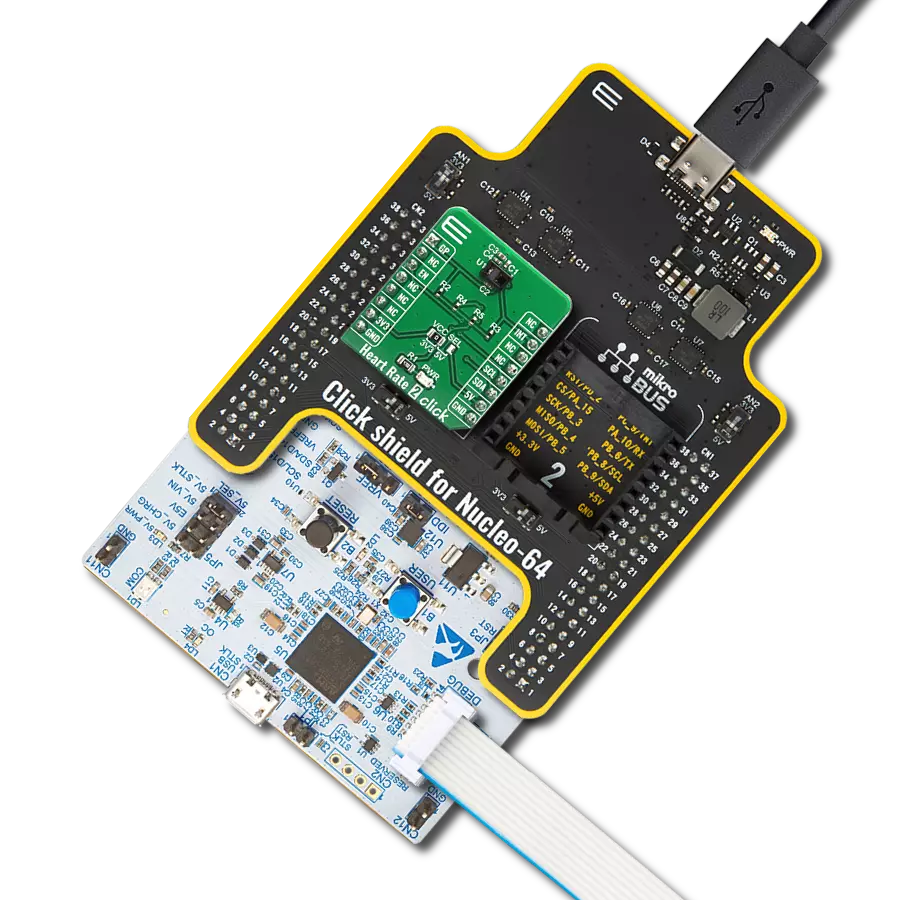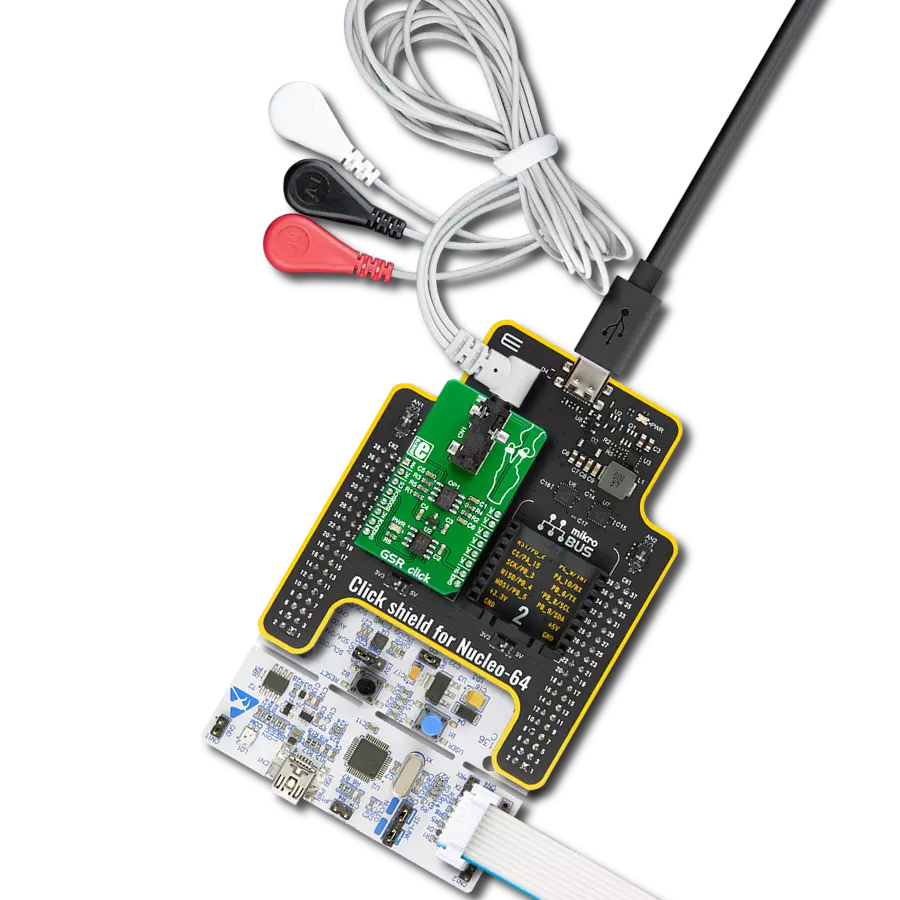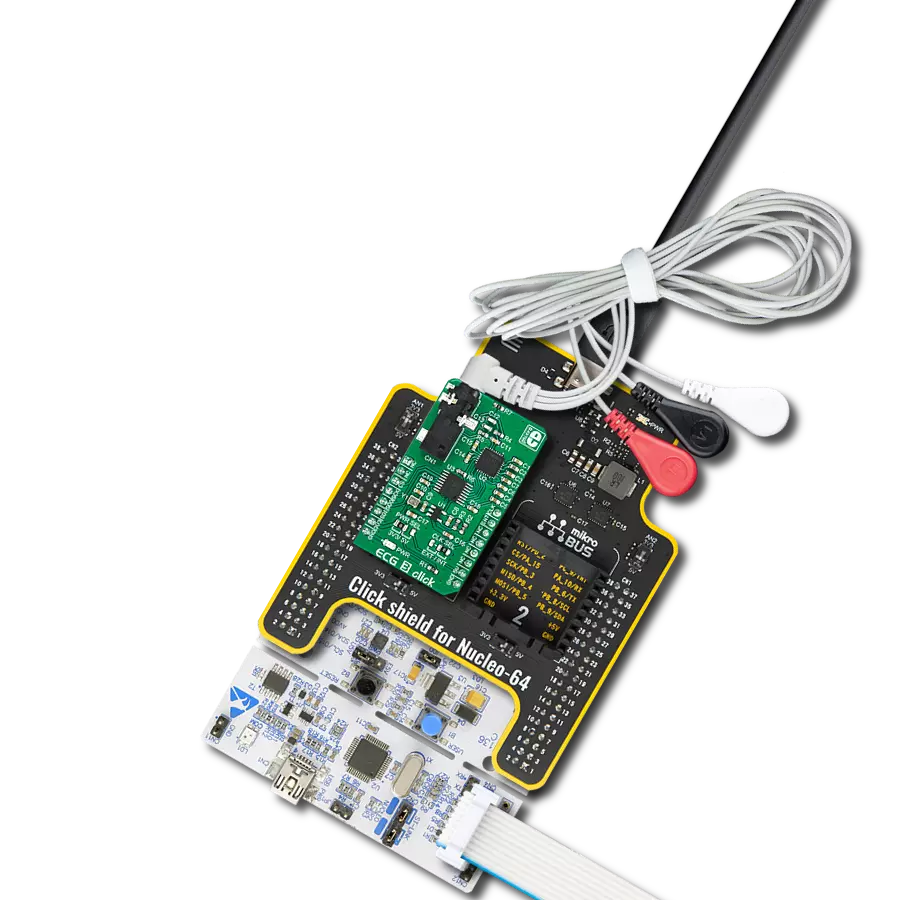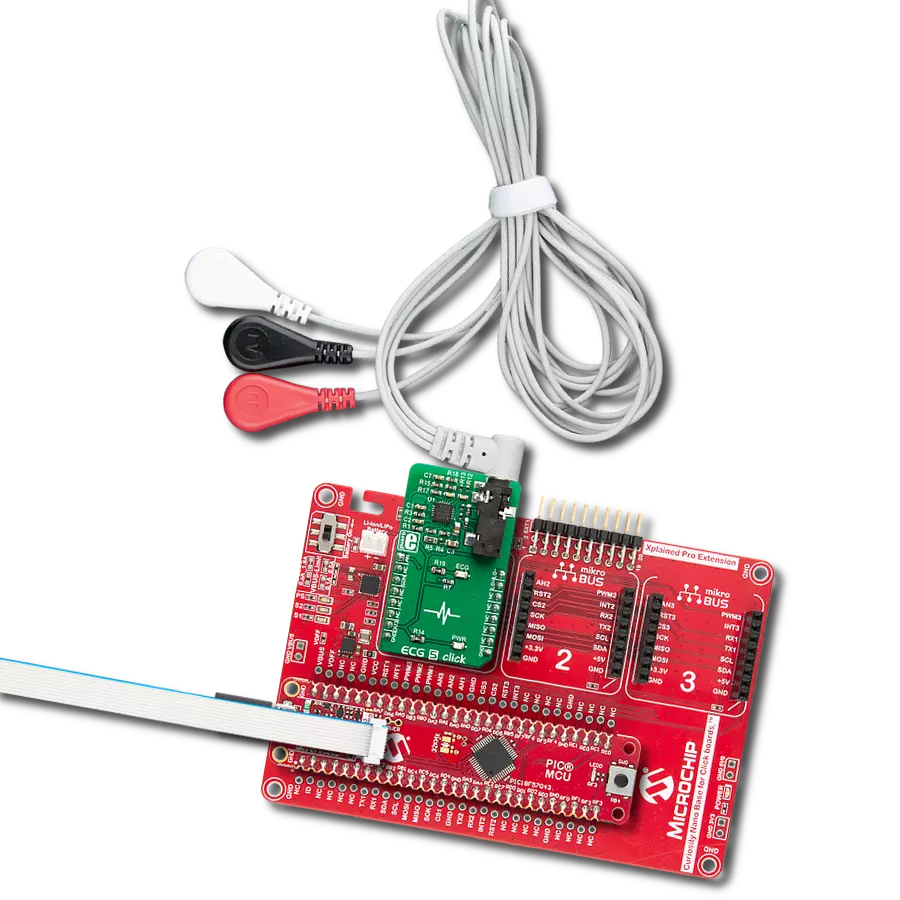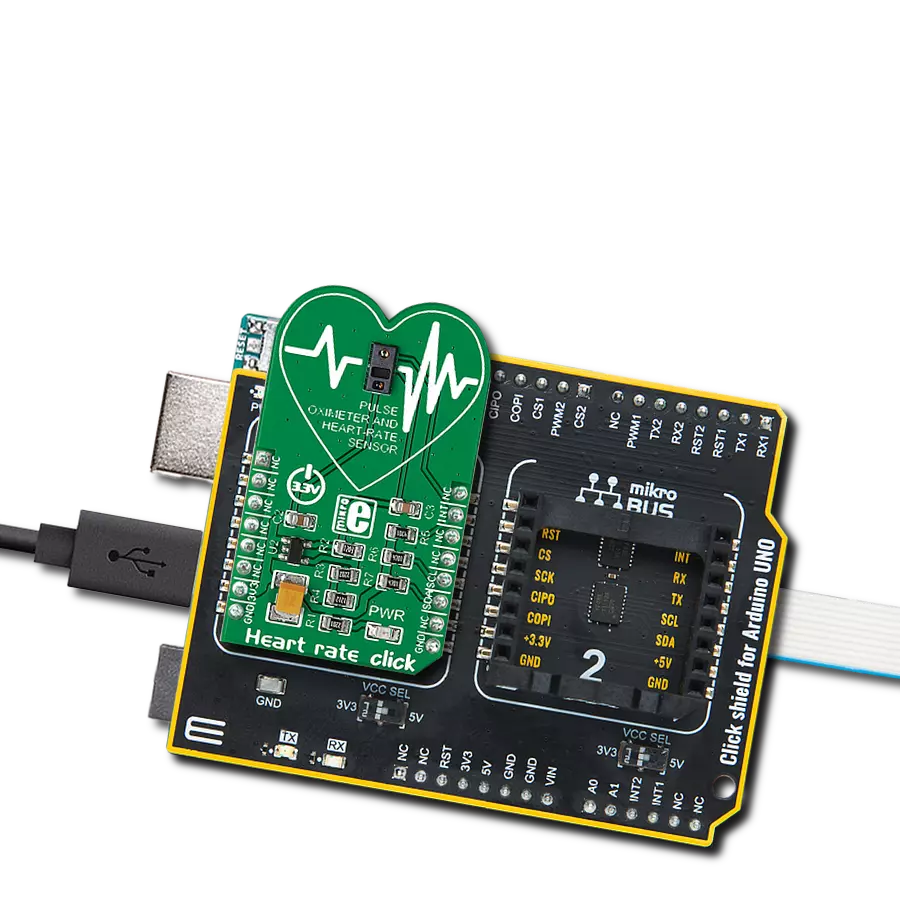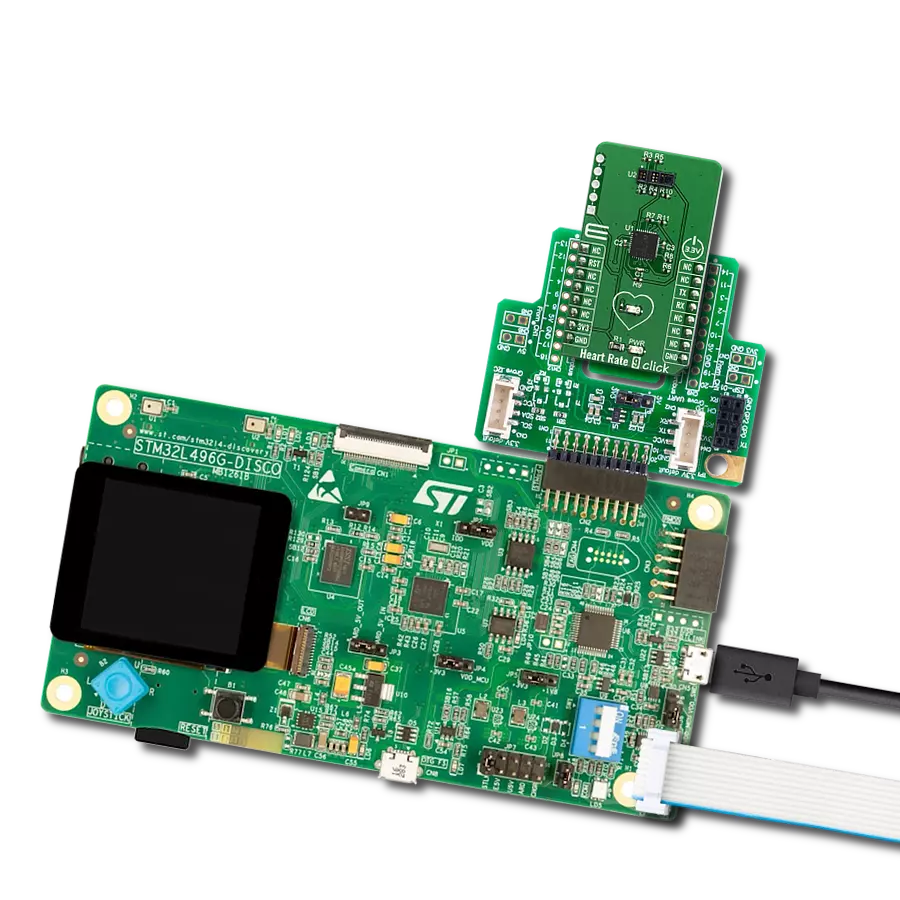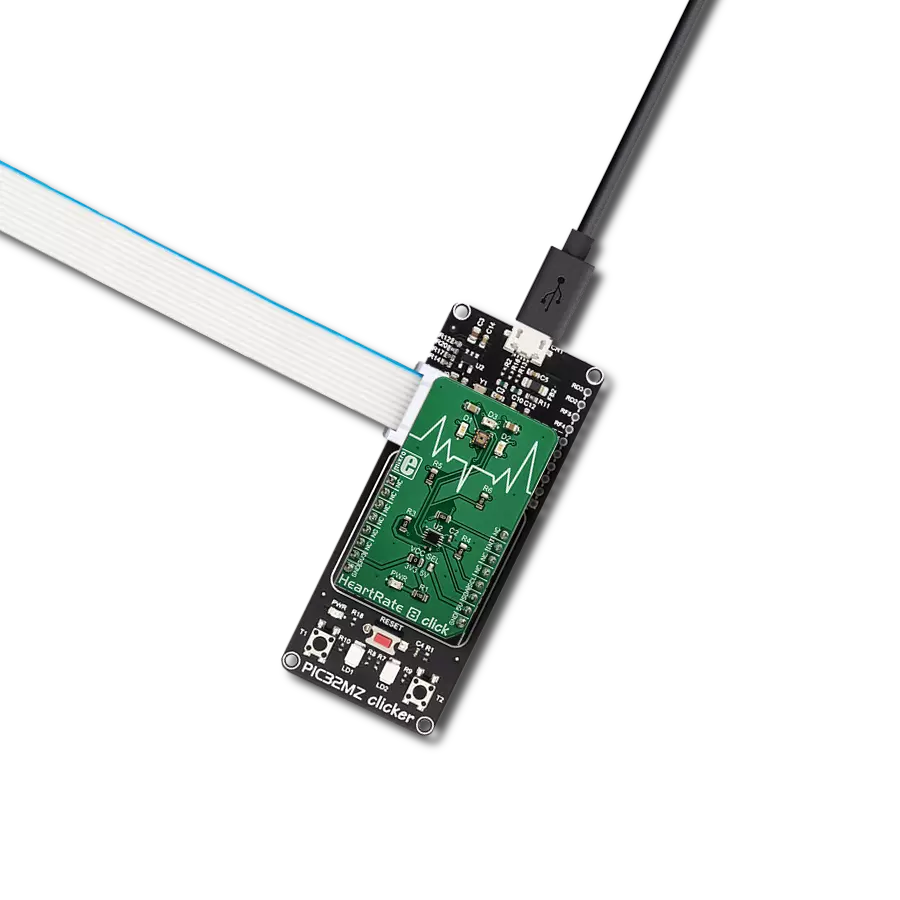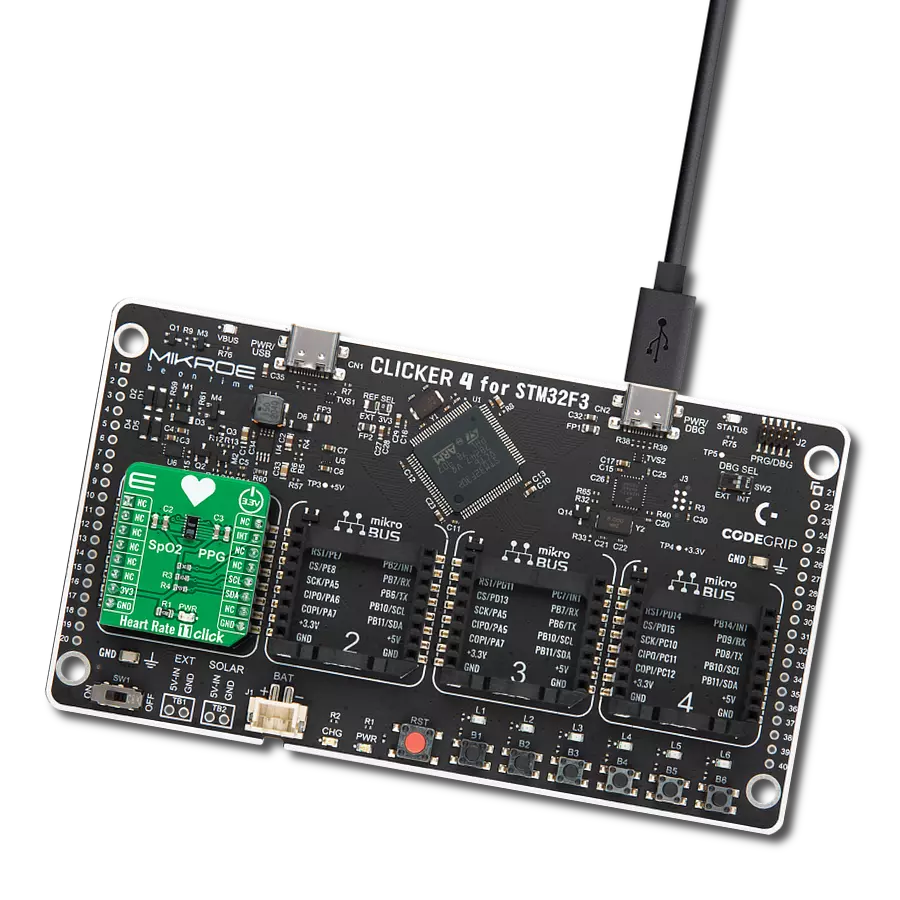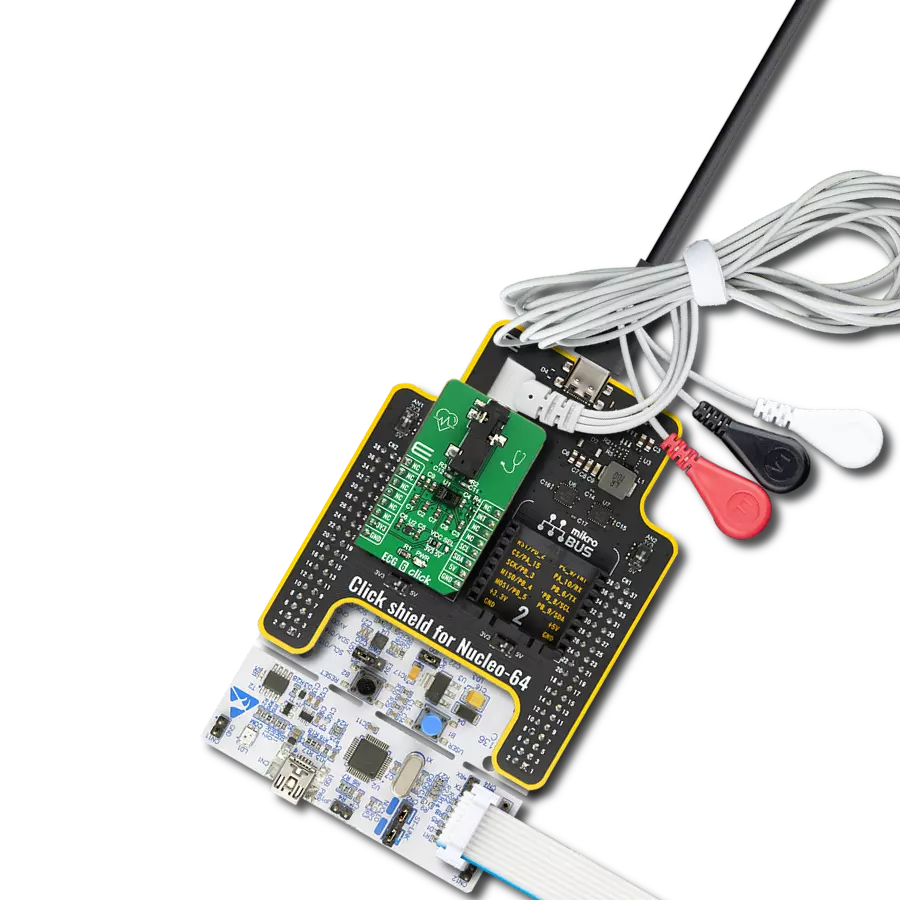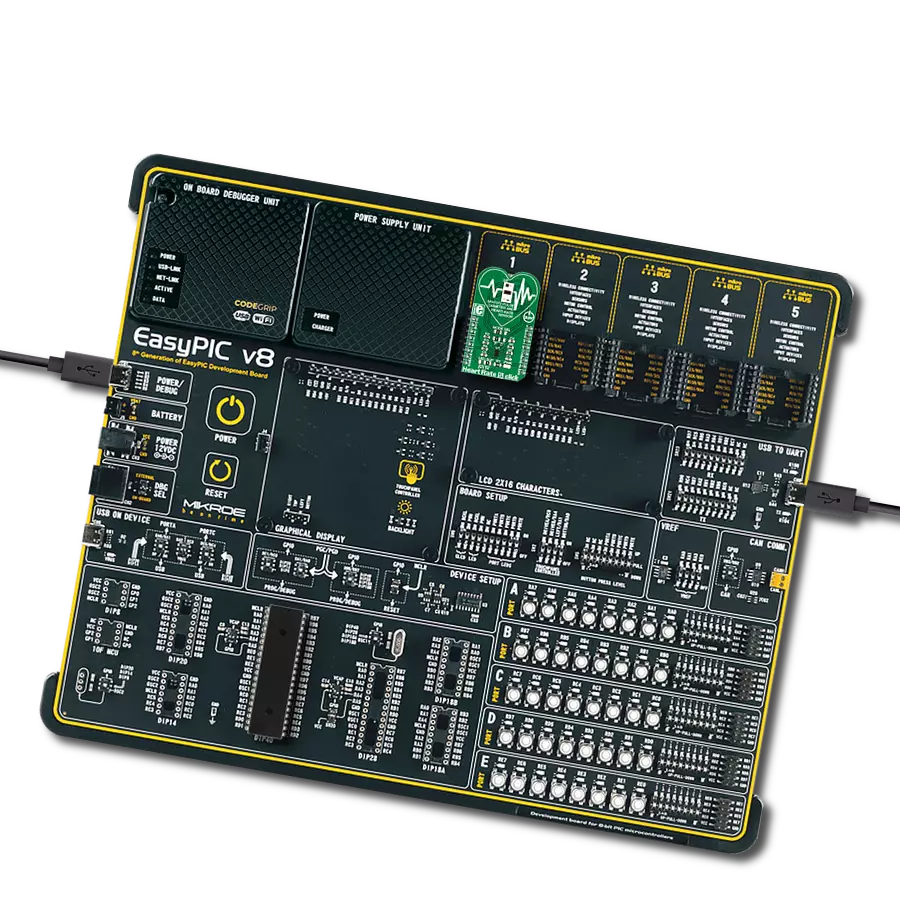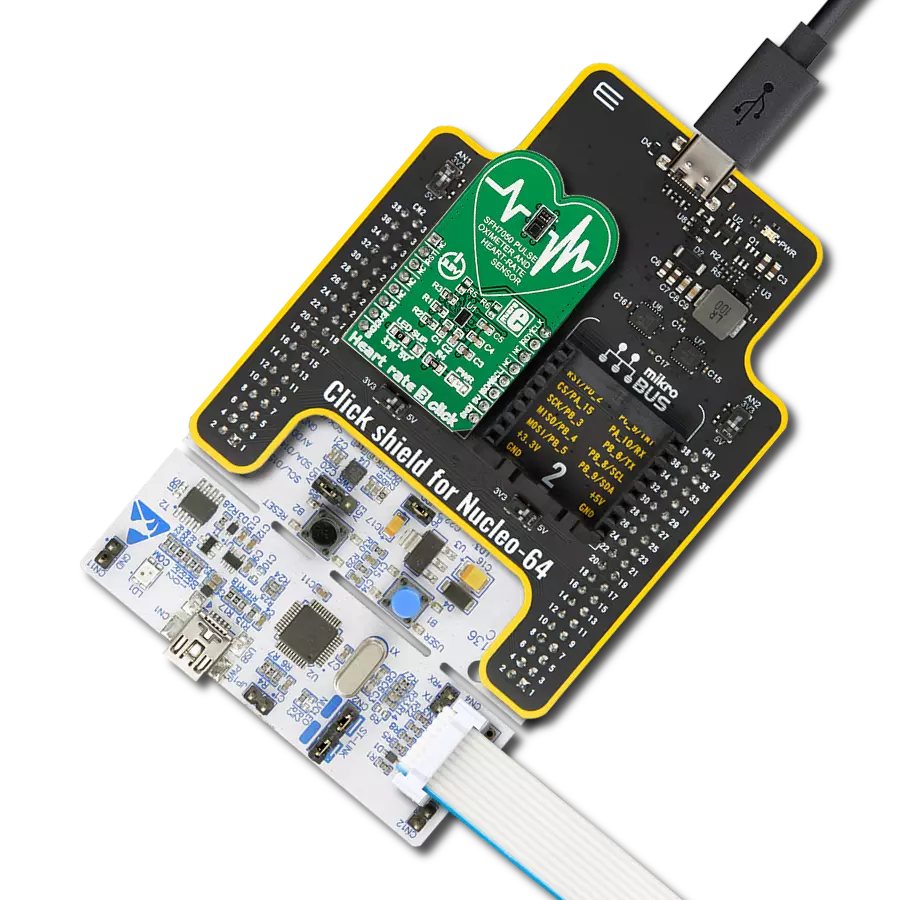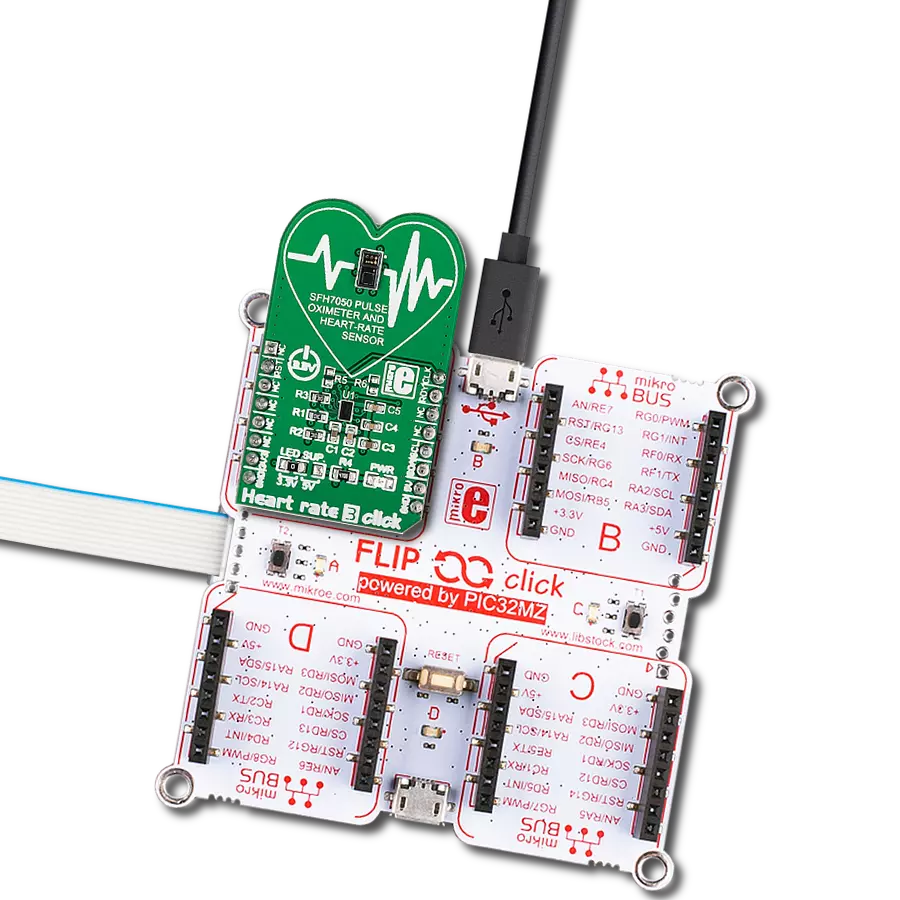Step into the future of vital-sign tracking by combining PPG and ECG technology for precise pulse rate measurement and comprehensive bio potential analysis
A
A
Hardware Overview
How does it work?
ECG/GSR Click is based on the AS7030B, a vital sign sensor based on Photoplethysmography (PPG) and Electrocardiogram (ECG) operations from AMS-AG. These two popular methods are suitable for heart rate monitoring (HRM) and heart rate variability (HRV), which measure the pulse rate by sampling light modulated by blood vessels that expand and contract as blood pulses through them. The ECG is the reference for any measurement of the bio-potential generated by the heart. This vital sign sensor features a low-noise analog front end, a single device integrated optical solution, and a synchronous demodulator. It consists of two 527nm green LEDs and one 940nm IR LED. The built-in infrared emitter and dedicated photodiode enable easy integration of the proximity function. Besides the HRM and SpO2, the AS7030B
is also anoptical measurement system for GSR (galvanic skin resistivity) and skin temperature obtained via an external temperature sensor connected to an onboard header labeled NTC. ECG/GSR Click communicates with MCU using the standard I2C 2-Wire interface that supports Standard-Mode (100 kHz) and Fast-Mode (400 kHz) operations. Also, it uses two additional pins, the INT pin of the mikroBUS™ socket, used as an interrupt, and the EN pin, routed on the CS pin of the mikroBUS™ socket, used to put the AS7030B into Normal operation mode or in a Shutdown. The AS7030B does not require a specific Power-Up sequence but requires a supply voltage of 3.8V to work correctly. Therefore, the Click board™ uses a low dropout linear regulator AP7331 from Diodes Incorporated, providing a 3.8V out of 5V mikroBUS™
rail.This Click board™ consists of two input channels routed to the 3.5mm jack connectors labeled as ECG and GSR, to which a 1m long ECG/EMG cable connects the electrodes to the appropriate Click board™ securely. The two electrode holders consist of a metal piece with a dent in the middle that perfectly fits the rivets on the electrodes. The contact with the measurement Click board™ remains good and secure while mounting the cable's electrodes is simple and easy. This Click board™ can operate with either 3.3V or 5V logic voltage levels selected via the VCC SEL jumper. This way, both 3.3V and 5V capable MCUs can use the communication lines properly. However, the Click board™ comes equipped with a library containing easy-to-use functions and an example code that can be used, as a reference, for further development.
Features overview
Development board
PIC18F57Q43 Curiosity Nano evaluation kit is a cutting-edge hardware platform designed to evaluate microcontrollers within the PIC18-Q43 family. Central to its design is the inclusion of the powerful PIC18F57Q43 microcontroller (MCU), offering advanced functionalities and robust performance. Key features of this evaluation kit include a yellow user LED and a responsive
mechanical user switch, providing seamless interaction and testing. The provision for a 32.768kHz crystal footprint ensures precision timing capabilities. With an onboard debugger boasting a green power and status LED, programming and debugging become intuitive and efficient. Further enhancing its utility is the Virtual serial port (CDC) and a debug GPIO channel (DGI
GPIO), offering extensive connectivity options. Powered via USB, this kit boasts an adjustable target voltage feature facilitated by the MIC5353 LDO regulator, ensuring stable operation with an output voltage ranging from 1.8V to 5.1V, with a maximum output current of 500mA, subject to ambient temperature and voltage constraints.
Microcontroller Overview
MCU Card / MCU
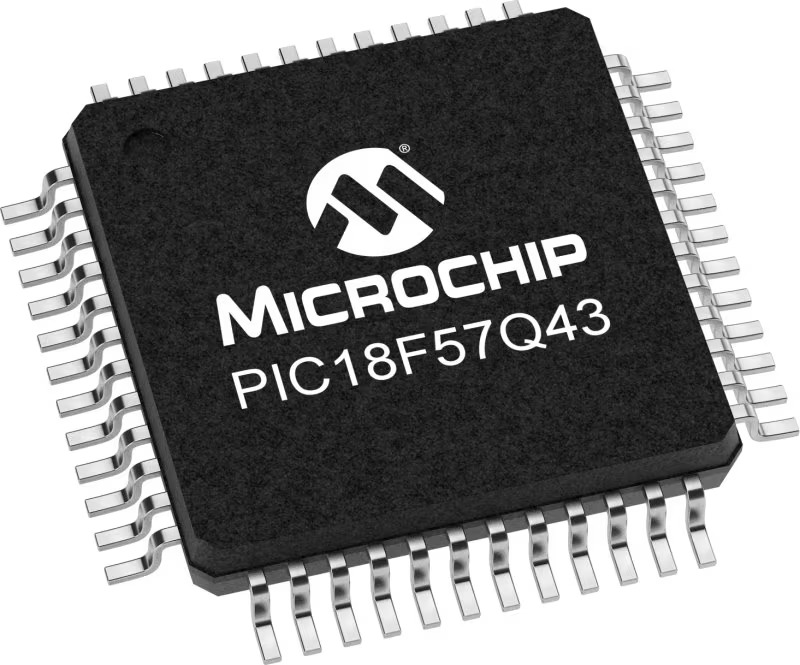
Architecture
PIC
MCU Memory (KB)
128
Silicon Vendor
Microchip
Pin count
48
RAM (Bytes)
8196
You complete me!
Accessories
Curiosity Nano Base for Click boards is a versatile hardware extension platform created to streamline the integration between Curiosity Nano kits and extension boards, tailored explicitly for the mikroBUS™-standardized Click boards and Xplained Pro extension boards. This innovative base board (shield) offers seamless connectivity and expansion possibilities, simplifying experimentation and development. Key features include USB power compatibility from the Curiosity Nano kit, alongside an alternative external power input option for enhanced flexibility. The onboard Li-Ion/LiPo charger and management circuit ensure smooth operation for battery-powered applications, simplifying usage and management. Moreover, the base incorporates a fixed 3.3V PSU dedicated to target and mikroBUS™ power rails, alongside a fixed 5.0V boost converter catering to 5V power rails of mikroBUS™ sockets, providing stable power delivery for various connected devices.
3-wire ECG/EMG cable comes with a convenient 3.5mm phone jack, and it is designed for electrocardiogram recording. This 1m cable is a practical companion for medical professionals and enthusiasts. To complement this cable, you can also use single-use adhesive ECG/EMG electrodes measuring 48x34mm, each equipped with an ECG/EMG cable stud adapter. These electrodes ensure a seamless experience when paired with our ECG/EMG cable and guarantee reliable ECG/EMG signal transmission for comprehensive cardiac monitoring. Trust in the accuracy and convenience of this setup to effortlessly record electrocardiograms and electromyograms with confidence.
Used MCU Pins
mikroBUS™ mapper
Take a closer look
Click board™ Schematic

Step by step
Project assembly
Track your results in real time
Application Output
1. Application Output - In Debug mode, the 'Application Output' window enables real-time data monitoring, offering direct insight into execution results. Ensure proper data display by configuring the environment correctly using the provided tutorial.

2. UART Terminal - Use the UART Terminal to monitor data transmission via a USB to UART converter, allowing direct communication between the Click board™ and your development system. Configure the baud rate and other serial settings according to your project's requirements to ensure proper functionality. For step-by-step setup instructions, refer to the provided tutorial.
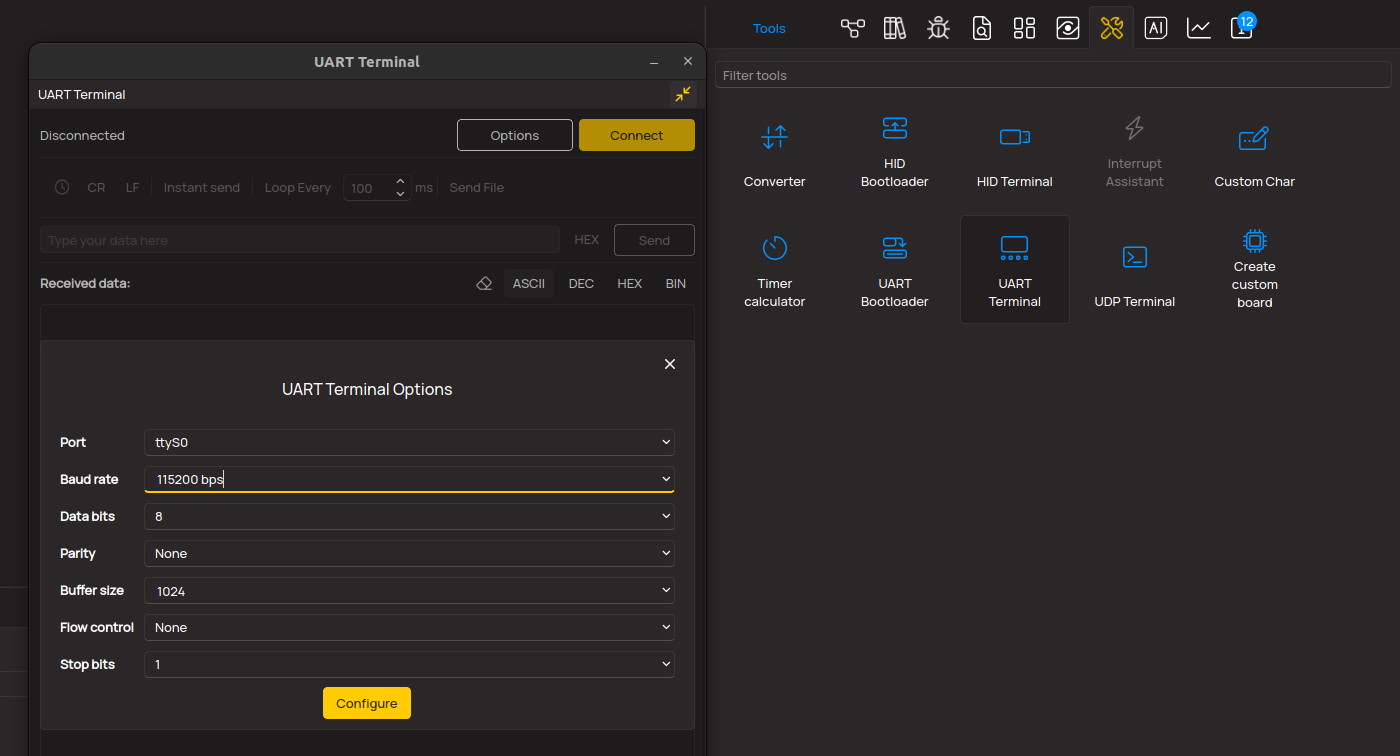
3. Plot Output - The Plot feature offers a powerful way to visualize real-time sensor data, enabling trend analysis, debugging, and comparison of multiple data points. To set it up correctly, follow the provided tutorial, which includes a step-by-step example of using the Plot feature to display Click board™ readings. To use the Plot feature in your code, use the function: plot(*insert_graph_name*, variable_name);. This is a general format, and it is up to the user to replace 'insert_graph_name' with the actual graph name and 'variable_name' with the parameter to be displayed.
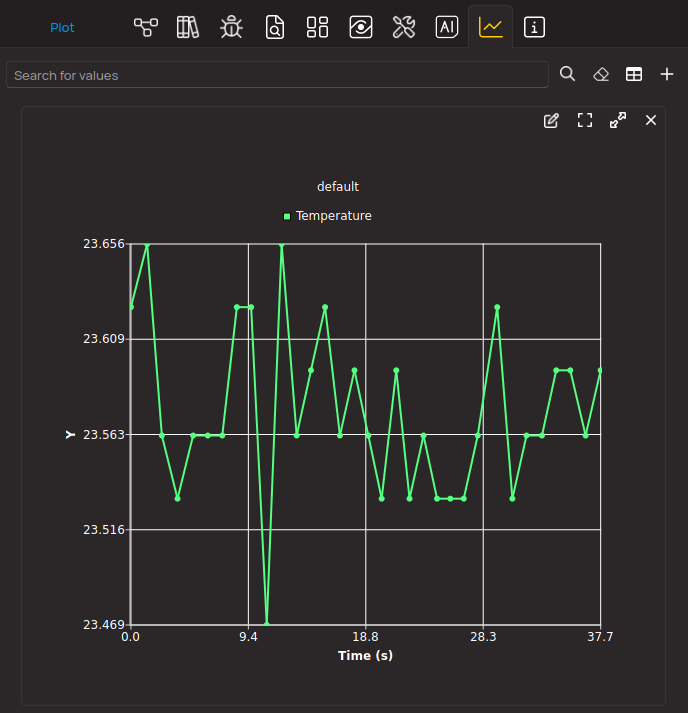
Software Support
Library Description
This library contains API for ECG/GSR Click driver.
Key functions:
void ecg_gsr_cfg_setup ( ecg_gsr_cfg_t *cfg );- Config Object Initialization function.ecg_gsr_err_t ecg_gsr_init ( ecg_gsr_t *ctx, ecg_gsr_cfg_t *cfg );- Initialization function.void ecg_gsr_default_cfg ( ecg_gsr_t *ctx );- Click Default Configuration function.
Open Source
Code example
The complete application code and a ready-to-use project are available through the NECTO Studio Package Manager for direct installation in the NECTO Studio. The application code can also be found on the MIKROE GitHub account.
/*!
* @file main.c
* @brief ECG GSR Click example.
*
* # Description
* This application collects data from the sensor, calculates it and then logs
* the result.
*
* The demo application is composed of two sections :
*
* ## Application Init
* Initializes driver, performs SW reset of all the registers, which puts
* the registers in their initial state.
*
* ## Application Task
* Depending on the user selection, application measures:
* 1. value of oxygen level in human's blood or
* 2. heartrate or
* 3. galvanic skin response
*
* \author MikroE Team
*/
#include "ecggsr.h"
#include "board.h"
#include "log.h"
// ------------------------------------------------------------------ VARIABLES
// ECG GSR context instance declaration.
static ecggsr_t ecggsr;
// ECG GSR configuration instance declaration.
ecggsr_cfg_t ecggsr_cfg;
// Logger context instance declaration.
static log_t logger;
// Device id slot.
static uint8_t dev_id = 0;
// Status of the ADC_DATA_L register.
static uint8_t adc_data_l_reg = 0;
// Status of the ADC_DATA_L register.
static uint8_t adc_data_h_reg = 0;
// Status of the low register of ADC.
static uint8_t adc_result_l = 0;
// Status of the high register of ADC.
static uint8_t adc_result_h = 0;
// ADC result.
static uint16_t adc_result = 0;
// ------------------------------------------------------ APPLICATION FUNCTIONS
void ecggsr_get_oxy_saturation( void )
{
// SEQ_START register. Start one ADC conversion.
ecggsr_write_reg( &ecggsr, ECGGSR_SEQ_START_REG, ECGGSR_START_ADC_CONVERSION );
Delay_1ms( );
ecggsr_write_reg( &ecggsr, ECGGSR_SEQ_START_REG, ECGGSR_START_ADC_CONVERSION );
Delay_5ms( );
// Read lower 8 bits of raw ADC data.
ecggsr_read_reg( &ecggsr, ECGGSR_ADC_DATA_L_REG, &adc_data_l_reg, 1 );
adc_result_l = adc_data_l_reg - ECGGSR_PPG_SCALE_VAL;
// Read higher 8 bits of raw ADC data.
ecggsr_read_reg( &ecggsr, ECGGSR_ADC_DATA_H_REG, &adc_data_h_reg, 1 );
adc_result_h = adc_data_h_reg & ECGGSR_ADC_DATA_H_MASK;
// Raw ADC result.
adc_result = ( ( uint16_t ) adc_result_h << 8 ) | adc_result_l;
if ( adc_result < ECGGSR_PPG_H_THRESHOLD )
{
adc_result = ECGGSR_PPG_H_THRESHOLD;
}
if ( adc_result_l > ECGGSR_PPG_MAX_VAL )
{
adc_result = ECGGSR_PPG_MAX_VAL;
}
// Final Oximeter results.
log_printf( &logger, "Level of oxygen saturation in your blood: %u\r\n", adc_result );
Delay_1sec ( );
}
void ecggsr_get_heartrate( void )
{
// SEQ_START register. Start one ADC conversion.
ecggsr_write_reg( &ecggsr, ECGGSR_SEQ_START_REG, ECGGSR_START_ADC_CONVERSION );
Delay_1ms( );
ecggsr_write_reg( &ecggsr, ECGGSR_SEQ_START_REG, ECGGSR_START_ADC_CONVERSION );
Delay_5ms( );
// Read lower 8 bits of raw ADC data.
ecggsr_read_reg( &ecggsr, ECGGSR_ADC_DATA_L_REG, &adc_data_l_reg, 1 );
adc_result_l = adc_data_l_reg;
// Read higher 8 bits of raw ADC data.
ecggsr_read_reg( &ecggsr, ECGGSR_ADC_DATA_H_REG, &adc_data_h_reg, 1 );
adc_result_h = ( adc_data_h_reg & ECGGSR_ADC_DATA_H_MASK );
// Raw ADC result.
adc_result = ( ( uint16_t ) adc_result_h << 8 ) | adc_result_l;
// Final heartrate results.
log_printf( &logger, "%u\r\n", adc_result );
}
void ecggsr_get_gal_skin_resp( void )
{
// SEQ_START register. Start one ADC conversion.
ecggsr_write_reg( &ecggsr, ECGGSR_SEQ_START_REG, ECGGSR_START_ADC_CONVERSION );
Delay_1ms( );
// SEQ_START register. Start one ADC conversion.
ecggsr_write_reg( &ecggsr, ECGGSR_SEQ_START_REG, ECGGSR_START_ADC_CONVERSION );
Delay_5ms( );
// Read lower 8 bits of raw ADC data.
ecggsr_read_reg( &ecggsr, ECGGSR_ADC_DATA_L_REG, &adc_data_l_reg, 1 );
adc_result_l = adc_data_l_reg;
// Read higher 8 bits of raw ADC data.
ecggsr_read_reg( &ecggsr, ECGGSR_ADC_DATA_H_REG, &adc_data_h_reg, 1 );
adc_result_h = adc_data_h_reg & ECGGSR_ADC_DATA_H_MASK;
// Raw ADC result.
adc_result = ( ( uint16_t ) adc_result_h << 8 ) | adc_result_l;
// Final Galvanic Skin Response results.
log_printf( &logger, "%u\r\n", ( uint16_t ) adc_result );
}
void application_init ( void )
{
log_cfg_t log_cfg;
/**
* Logger initialization.
* Default baud rate: 115200
* Default log level: LOG_LEVEL_DEBUG
* @note If USB_UART_RX and USB_UART_TX
* are defined as HAL_PIN_NC, you will
* need to define them manually for log to work.
* See @b LOG_MAP_USB_UART macro definition for detailed explanation.
*/
LOG_MAP_USB_UART( log_cfg );
log_init( &logger, &log_cfg );
log_info( &logger, "---- Application Init ----" );
// Click initialization.
ecggsr_cfg_setup( &ecggsr_cfg );
ECGGSR_MAP_MIKROBUS( ecggsr_cfg, MIKROBUS_1 );
ecggsr_init( &ecggsr, &ecggsr_cfg );
Delay_1sec();
ecggsr_default_cfg( &ecggsr, &ecggsr_cfg );
Delay_1sec();
}
void application_task( void )
{
// ------------------------------------------------------------
// Check the presence of the ECG GSR Click by reading device ID.
// ------------------------------------------------------------
ecggsr_read_dev_id( &ecggsr, &dev_id );
if ( ECGGSR_DEV_ID == dev_id )
{
// ------------------------------------------------------------
// Enable desired functionality of the ECG GSR Click.
// ------------------------------------------------------------
if ( ENABLE_OXIMETER_FUNCTIONALITY == ecggsr_cfg.click_functionality )
{
ecggsr_get_oxy_saturation( );
}
else if ( ENABLE_HEARTRATE_FUNCTIONALITY == ecggsr_cfg.click_functionality )
{
ecggsr_get_heartrate( );
}
else if ( ENABLE_GALVANIC_SKIN_RESPONSE_FUNCTIONALITY == ecggsr_cfg.click_functionality )
{
ecggsr_get_gal_skin_resp( );
}
}
}
int main ( void )
{
/* Do not remove this line or clock might not be set correctly. */
#ifdef PREINIT_SUPPORTED
preinit();
#endif
application_init( );
for ( ; ; )
{
application_task( );
}
return 0;
}
Additional Support
Resources
Category:Biometrics























